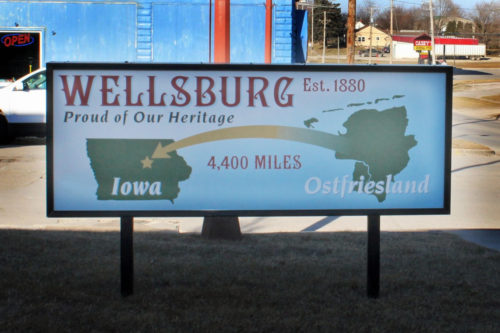By Arvid Huisman

The residents of Wellsburg in Grundy County take pride in their East Frisian roots. This sign greets visitors as they enter Wellsburg on the short county road from U.S. Hwy. 20.
Thousands of Iowans owe a debt of gratitude to Arend J. Arends for his courage and foresight, but have no idea who he was. If you are a descendant of immigrants from the far northwest corner of Germany, you should know about this man who led the wave of East Frisian migration to the Midwest and to Iowa.
Arends was a successful young wheelwright in Neermor, a German village just eight miles east of Dollard Bay which separates far northwest Germany from the Netherlands. Arends had served as a journeyman wheelwright in Amsterdam and returned home to set up his own business.
While working in Amsterdam, Arends befriended another wheelwright and when he returned to Neermor, his friend sailed to the United States and established himself in St. Louis, Mo. In letters to Arends his friend extolled the virtues and opportunities of his new land and encouraged Arends to join him.
Arends’ business was doing well but he had bigger dreams. In March 1847, he and his wife, Geeske, and six friends and relatives left Neermor for the Port of Bremerhaven from where they embarked on a six-week sea journey to the U.S.
Ethnically, Arends and his entourage were East Frisians who lived in a region of Germany known as Ostfriesland, or in English, East Friesland.
During the Middle Ages a wide swath of northern Europe — from what is now the Netherlands east to the Baltic region — encompassed the nation of Friesland. Over time, Friesland lost its sovereignty and was divided into provinces in the Netherlands and Germany.
The westernmost of the German Frisians inhabited East Friesland. Now a part of the German state of Lower Saxony, East Friesland comprised approximately 1,200 square miles of the northwestern corner of Germany and the East Frisian Islands off the North Sea coast.
A predominately rural region, East Friesland was less prosperous than other parts of Germany. Land was limited and there were few opportunities for individuals without wealth. Unlike successful young Arends, many families lived in poverty.
TO READ THE ENTIRE STORY AND OTHER FASCINATING STORIES ABOUT IOWA HISTORY, subscribe to Iowa History Journal. You can also purchase back issues at the store.
